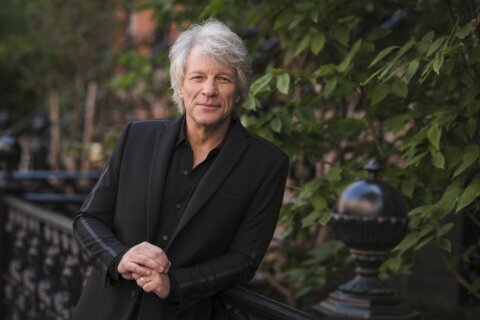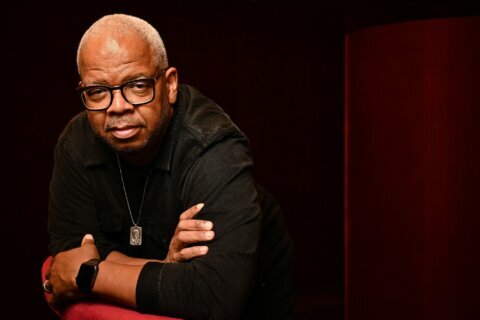
He was the first hip-hop artist ever inducted into the Rock & Roll Hall of Fame. Now, he’s revealing his music-making secrets.
On Saturday, Grandmaster Flash will hit U Street Music Hall to school fans on the history of the very genre he invented in an event titled “Hip-Hop: People, Places & Things.”
“It’s a ‘jam-ucation’ — we’re jamming, but I’m giving you an education at the same time,” Grandmaster Flash told WTOP. “People need to understand how I came up with a way to manually cut and paste one area of a composition of a different genre to another, on time [and] to the beat, continuously. How did I do it? I have to explain it.”
Flash will DJ while an LED screen shows a live feed of his hands on the turntables.
“What my team decided to do was put together a visual presentation while I’m DJing,” Flash said. “For example, [the presentation shows] how I created the quick-mix theory and the art of how I manipulate the disc back and forth.
I’ve tried for decades to explain how important that is to extend the beat so the rappers have a backing track to speak on. … I have cameras on the turntables so you can physically see how I invented this in the ’70s.”
The video wall also includes footage of important people and places in hip-hop.
“There’s also places on the visual presentation of people’s places where we used to live before we became famous,” Flash said. “I lived in the projects, so did Jay-Z, so did Biggie.
We show all these places on the screen. … That’s pretty much what ‘Hip-Hop: People, Places & Things’ is. ‘Things’ is turntables, ‘places’ was in the Bronx, ‘people’ is various people. I kinda want to just give a visual presentation along with my audio.”
Flash was born in Barbados in 1958, but his family moved to New York City. He grew up in the Bronx surrounded by all types of different music playing in his household.
“I would hear a smorgasbord of different types of music on a daily basis,” Flash said. “My older sister Violet might play Motown, my other sister Carmetta might play disco, Mom may play Lena Horne, Dad may play Miles Davis.
… I had to figure out a way to [manually] have all these different genres hold hands. Just like in school when the teacher is crossing the street and says, ‘Everybody hold hands!’ I did that with music.”
His dream of combining all genres became a reality via boom boxes in the park.
“Breakdancers is originally what I created this turntable technique for,” Flash said. “I had my crappy sound system in the park, I would put a mic [up] to see if there was anybody who could vocalize to this new style of this continuous drum break.
… I would take a track from any group, let’s say Thin Lizzy ‘Johnny the Fox.’ … I would take a Jackson 5 break or a Sly & The Family Stone break on ‘Sing a Simple Song.’ The drum break is so incredible, but it’s so short, so I had to find a way to cut and paste.”
Back then, the “cutting and pasting” had to be done manually with elbow grease.
“Back in the ’70s, we had no technology, no computers, no studios, no beat machines, no apps, no nothing,” Flash said. “So how would the music track be generated?
We had to get duplicate copies of the record and pick the desired section where the drum solo was, which a lot of time was like 10 seconds, then cut and paste it and extend it for three or four minutes so the rapper would have a beat to speak on.”
That meant voracious shopping in record stores to find the perfect drum break.
“When I went shopping for records to find that drum break, we went shopping in the pop section of the record store, or the rock section, or the jazz section, or the blues section, or the funk section, or the R&B section, or the alternative section, or the Caribbean section, or the Latin section, just to find that drum break,” Flash said.
Let’s just say ‘Good Times’ by Chic … I would listen to that on the turntables and go, ‘Wow, this is great for me to play in the gymnasium or the community center next week!'”
Other times, he’d listen to an entire record only to find nothing usable.
“When we go record shopping, it’s a crapshoot, but once you break the plastic, you buy it, like it or not,” Flash said. “So we would buy records on guessing. I’d bring the record home and play every cut trying to find that drum solo and it would all be crap, so that would go in the crap crate.”
However, this discard pile would later come in handy, providing dummy copies for Flash to secretly conceal his art from rival DJs snooping around his turntables.
“One of the biggest jokes of the streets was we would soak the labels off and put the bull-crap label on the hot break … so when a DJ would come on-the-low to stare at my turntables, they would go buy the crap ones. They would go buy the stiffs,” Flash said. “We were too prideful to ask, ‘What’s that break?’
We’d have to send a spy in because we heard about it in the street or heard it on a mixtape. … It’s dastardly, it’s disgusting, it’s funny, but this is how you kept your secrets. It’s how we kept our arsenal private.”
Now, all these decades later, the magician is finally ready to reveal his tricks.
“I come form a time where we used to keep things a secret because we were in competition with each other in the Bronx,” Flash said. “But we’re at an information age where sharing is paramount and extremely important.
… I decided to pull the sheet off it and show people how it’s done. … These kids want to know. This thing didn’t happen by someone just tripping over a wire. This is math, bars and science.”
He said hip-hop is such a dominant genre that fans need to appreciate its roots.
“As one of the elder statesmen and one of the architects of the culture, we need to say, ‘This is why this is,”” Flash said. “People need to know why this is the big monster that it is today.
It is arguably the biggest cultural musical phenom on the planet, so why is it? I like to go back to the beginning and say it was a bit of pop, a bit of rock, a bit of jazz, a bit of blues, a bit of funk, a bit of R&B, a bit of disco, a bit of Latin.”
Just like when he was a kid listening to his parents’ records, he insists it’s all genres.
“This is a multi-genre, multi-race situation,” Flash said. “Music has no color. … Dope music is dope music! … A funky drum break is a funky drum break.”
To this day, his deep knowledge of samples sparks fun debates with his kids.
“There’d be a hot song on the radio and I know it’s a sample,” Flash said. “They’d say, ‘Nah, dad. You’re old. That ain’t a sample.’ And I’m like, ‘You sure?’
I would go into my collection and I would play the original sample and they’d go, ‘Oh!’ There’s so much to teach the babies today. That’s what ‘Hip-Hop: People, Places & Things’ is.”
Hear my full conversation with Grandmaster Flash below:








